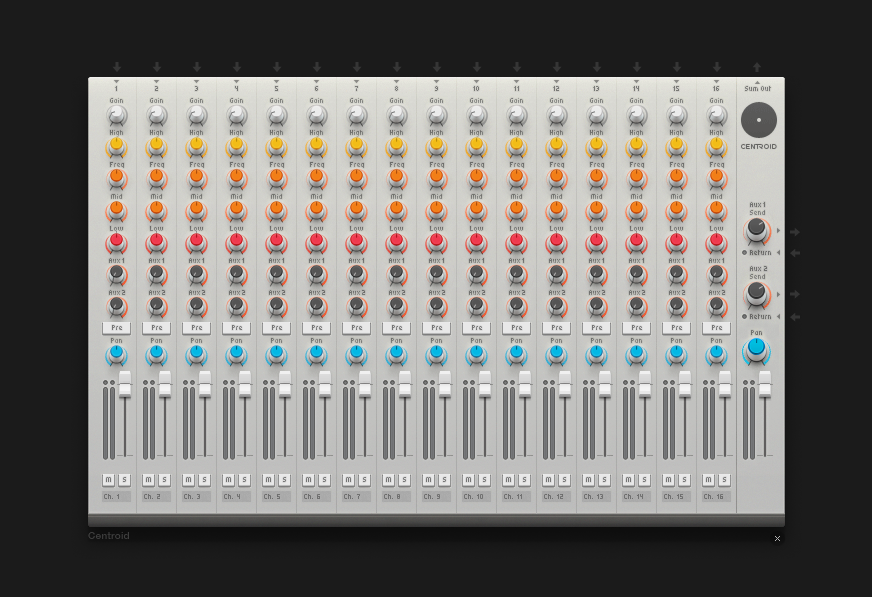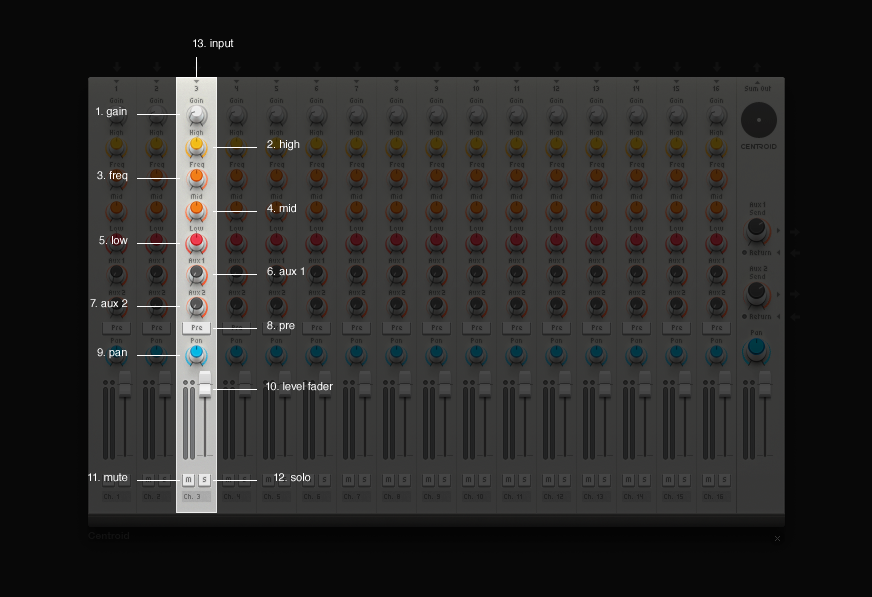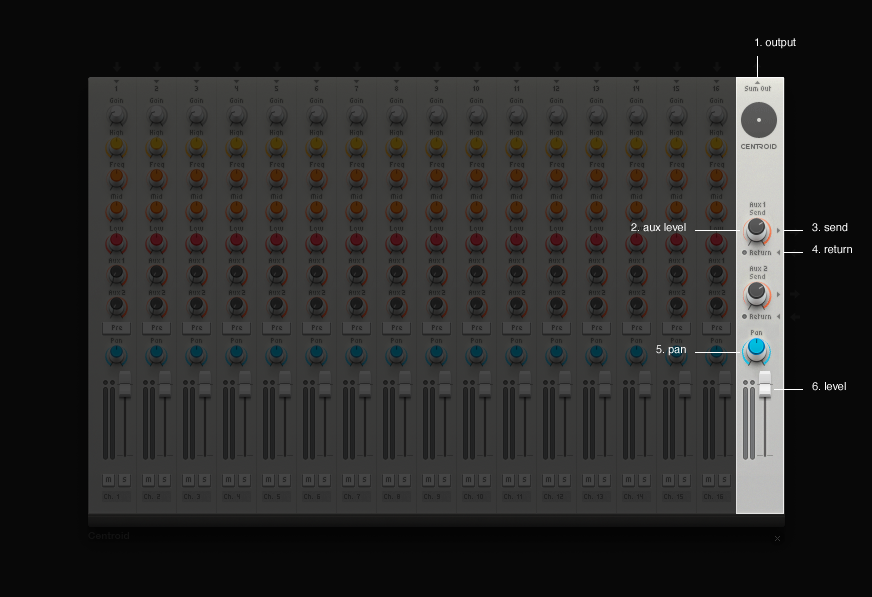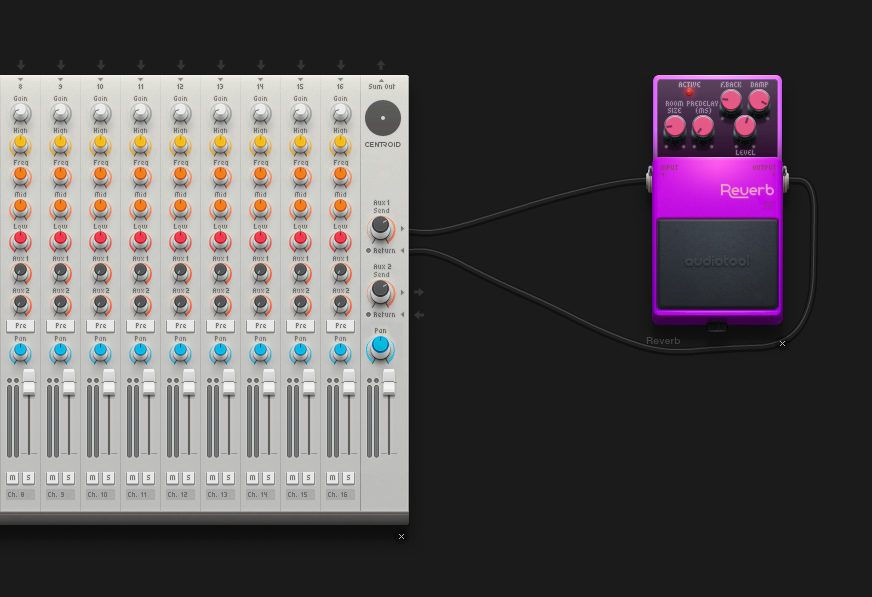Centroid
The Centroid is a studio mixer with up to 32 channels. Each of the channels have the same functionality, each channel includes a semi-parametric equaliser, panning and gain controls. The centroid also includes 2 auxiliary send/return inputs, this makes it possible for 2 different effect chains to be inputted through the device. Each channel has a set of controls which can be used to determine how much the signal from each channel is affected by the inputted effects. The Centroid is a very tough machine that will still work even if you stand on it.

Channel Controls
This is where each inputted channel can be adjusted individually. All channels include exactly the same parameters, for this reason the below image only labels the parameters of Channel 3.
NOTE: The below image only shows the controls found on channel 3 although all channel parameters work the same way for each channel.

gain - Control over the channels input gain.
high - Allows controls over the inputted signals high frequencies.
freq - This control is specific to the mid control, this control allows definition of how much of the signal is affected by the mid control.
mid - Allows control over the mid level of the inputted signal.
low - Control over the signals low frequencies.
aux 1 - Control over how much the signal is affected by whatever effects are being utilised through aux 1.
aux 2 - Control over how much the signal from the channel is affected by whatever effects are inputted through aux 2.
pre - Pre stands for pre-fader. This control is related to aux 1 and 2, this allows you to decide whether the inputted signal goes through aux 1 or 2 before going through the channels level fader. If pre is urned on this means that the signal will go through the level fader first.
pan - Individual panning for each channel.
level fader - Control over the volume of the inputted audio signal.
mute - Allows you to mute each channel individually.
solo - Exact opposite of mute, mutes all other channels apart from the channel where solo is selected. Solo allows for each channel to be played back individually without hearing any of the other channels.
input - Each channel’s input is located at the top of the channel. One device or a whole chain of devices can be plugged into each channel’s input.
Master Controls
The master controls are similar to the master controls of any other device, they control the device master output and allow for adjustments to be made to the output signal rather than each channel individually. The master controls also include the master controls and inputs for both aux 1 and 2.
NOTE: The below image only shows the controls for aux 1 since the controls for aux 1 and 2 are exactly the same.

output - This is the Centroid’s master output, this is where all of the channels are merged together into one cable.
aux level - Allows adjustment over how much of the effect chain inputted into aux 1 will be allowed into the device.
send - This is aux 1’s input, this is where an effect chain’s input can be inputted to aux 1.
return - This is where an effect chains output can be inputted to aux 1.
pan - Master panning control, this will affect the signal from all channels.
level - Centroids master volume control, this will affect the volume of every channel.
Aux
The Centroid includes 2 auxiliary modules. These each allow for an effect or a chain of effects to be inputted into the device, an effect pedals input can be plugged into send and the effect pedal output can be plugged into the return input. This makes it possible to add the effect to all, some or just one of the Centroid’s channels. It is then possible to adjust how much the effect or chain of effects will affect each channel individually. As well as the individual controls for aux 1 and 2 found in each channel aux 1 and 2 also have master level controls which are labelled on the above image.
Below: The below image shows a Reverb effect pedal utilising send/return with aux 1.

Adjust number of channels
The number of channels on the centroid isn’t static; it can be extended to up to 32, or shrunken down to 4 channels.
To add or remove a channel, simply right click on a channel:

You can also focus the Centroid (e.g. click on it) and use SHIFT+RIGHT to extend or SHIFT+LEFT to reduce the amount of channels. A warning will appear if a channel is about to be removed that is actually connected.
Channels without a custom name will now be named automatically. The Centroid basically traces the input signal flow, tries to find the best matching device and assigns its name to the channel. You can always override it with your own naming.